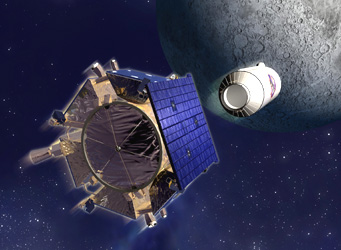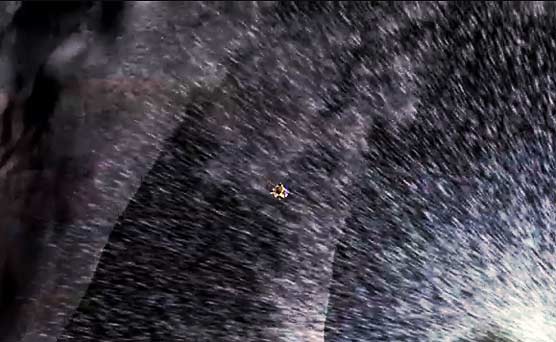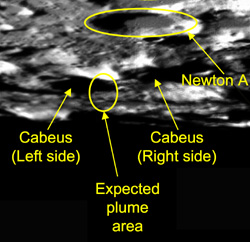Sending a spacecraft crashing into the Moon is nothing new. On September 12th, for example, I'm sure you were all celebrating the 50th anniversary of the Luna 2's crash landing in Palus Putredinis. NASA started its smashups a few years later with the Ranger series, followed by an assortment of Apollo parts. Lunar Prospector carried a bit of super-scientist Gene Shoemaker's cremated remains when it struck the Moon a decade ago. Japan's Kaguya orbiter had a flashy finale last June 10th that was captured by a large telescope on Earth.

LCROSS and its Centaur rocket prepare to crash into the Moon.
NASA
Early on Friday morning, October 9th, gravity and momentum will conspire to draw NASA's Lunar Crater Observation and Sensing Satellite (LCROSS) and its Centaur rocket into the Moon. They will strike an obscure crater named Cabeus that's 60 miles (100 km) across and close to the Moon's south pole.
It's the latter characteristic that will have countless telescopes on Earth — and a few off of it — locked in on Cabeus. (Impact site finder charts.) Based on NASA's latest (Oct. 7th) predictions, the rocket body will strike at 11:31:19 Universal Time (7:31:19 a.m. EDT, 4:31:19 a.m. PDT). The smaller, instrumented LCROSS shepherding craft will crash a few minutes later, at 7:35:45 UT, just after flying through and sampling the debris plume from the first strike with nine onboard instruments.
NASA has a great animation showing the sequence of events. I hope that the real event looks half this good!

The shepherd probe (center) sails into the impact plume from the rocket body in this frame from a NASA simulation of the expected sequence of events.
NASA
So why pick this dark and hard-to-observe site? Parts of the floor of Cabeus lie in permanent shadow — the Sun never shines there — and there's lots of circumstantial evidence that frozen water lies mixed into the dusty rubble inside Cabeus and numerous other craters near the Moon's poles. Slam a big enough bullet into such a deposit, the thinking goes, and the resulting plume of debris should be infused with water vapor that can be detected and quantified spectroscopically.
If any frozen water is really there.
Mission officials picked the time and place for LCROSS's demise such that the waning gibbous Moon will be high in the night sky for the phalanx of giant telescopes atop Mauna Kea in Hawaii. The viewing geometry also favors big observatories in California, Arizona, and New Mexico. Locations in North America west of the Mississippi River should see the Moon in a dark predawn sky, but those of us on the East Coast are out of luck — the Moon is still up at impact time, but so is the Sun.

A closeup of the LCROSS target area, acquired on August 11, 2009, with NMSU's 24-inch Tortugas telescope. Click on the image for a larger view, or go here for higher-resolution and wider-field versions as finder charts.
New Mexico State Univ / NASA-MSFC
So if you're among the geographically fortunate, what might you see? That depends.
First, it depends on how big a plume the impacts make. LCROSS's two main components — its bullets — are the 2.2-ton Centaur rocket that propelled the spacecraft to the Moon and a smaller, 0.6-ton "shepherd" that will guide both craft to the target. Shortly before the impact, the shepherd will separate and fall far enough behind the rocket's lifeless hulk (about 400 miles) to fly through the plume created by the Centaur before crashing itself at 1½ miles (2½ km) per second.
Theorists predict that the rocket's strike should trigger a distinct flash perhaps as bright as 6th magnitude in visible light. But terrestrial telescopes won't see that because it'll be hidden by the rim of the target crater — unless the aiming is off badly! You'll have better odds trying to spot the plume of debris lofted into the sunlight above ground zero following the hit. It's unclear how big and bright that transient curtain of dust will be. According to recent estimates by LCROSS scientists, the dense core of each plume might appear about as bright as the surface of Mars — not dazzling but perhaps detectable. A plume 6 miles (10 km) tall would be 5 arcseconds tall as seen from Earth — very tiny. (The whole Moon, by comparison, will appear 1,900 arcseconds in diameter.)
Second, how big is your telescope? Odds are you'll need an aperture of 10 to 12 inches to record the impact plume with a camera, more still if you want to see it by eye. NASA has a website with many more details and suggestions for would-be observers and imagers. Amateurs planning on watching for the event have also set up a Google group.
Just remember, warn the mission's plume gurus: This event is short (each plume may be visible for 20 to 120 seconds), low (1 to 20 miles in height), and dim (magnitude 6 to 11 for its brightest part).
And what about those of us who lack a light bucket? Check the LCROSS website for exact impact times and other late updates. See also NASA's tips on when and how to watch, including a list of events open to the public.
You can also watch the Centaur's rocket booster's crash from the perspective of the doomed shepherd spacecraft. Watch on NASA TV; coverage begins 1 hour 15 minutes beforehand, at 6:15 a.m. EDT (10:15 UT). If you have trouble with your browser plugins, you can watch in your favorite media player:
Stream for Windows Media Player
Stream for Real Player
QuickTime
More links:
Great zoom-in visualization of what the impact plume may actually look like, from a new NASA/Goddard press release (Oct. 8).
NASA's Impact Party Toolkit
Webcast from The Exploratorium in San Francisco
SLOOH telescope live feeds from Arizona (in darkness) and New Hampshite(daylight).
 1
1
Comments
MCDOWELL27Marcie
April 7, 2010 at 2:57 pm
I had a dream to make my organization, nevertheless I did not have got enough of money to do it. Thank God my dude proposed to use the mortgage loans. Thence I took the college loan and realized my old dream.
You must be logged in to post a comment.
You must be logged in to post a comment.